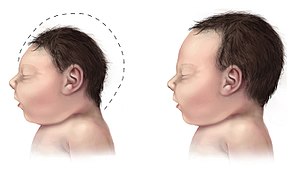Microcephaly
| Microcephaly | |
|---|---|
 |
|
| A baby with microcephaly (left) compared to a baby with a typical head size | |
| Classification and external resources | |
| Specialty | Medical genetics |
| ICD-10 | Q02 |
| ICD-9-CM | 742.1 |
| OMIM | 251200 |
| DiseasesDB | 22629 |
| MedlinePlus | 003272 |
| MeSH | D008831 |
Microcephaly is a medical condition in which the brain does not develop properly resulting in a smaller than normal head. Microcephaly may be present at birth or it may develop in the first few years of life. Often people with the disorder have an intellectual disability, poor motor function, poor speech, abnormal facial features, seizures, and dwarfism.
The disorder may stem from a wide variety of conditions that cause abnormal growth of the brain, or from syndromes associated with chromosomal abnormalities. A homozygous mutation in one of the microcephalin genes causes primary microcephaly. It serves as an important neurological indication or warning sign, but no uniformity exists in its definition. It is usually defined as a head circumference (HC) more than two standard deviations below the mean for age and sex. Some academics advocate defining it as head circumference more than three standard deviations below the mean for the age and sex.
There is no specific treatment that returns the head size to normal. In general, life expectancy for individuals with microcephaly is reduced and the prognosis for normal brain function is poor. Occasionally, some will grow normally and develop normal intelligence.
Affected newborns generally have striking neurological defects and seizures. Severely impaired development is common, but disturbances in motor functions may not appear until later in life.
Infants with microcephaly are born with either a normal or reduced head size. Subsequently, the head fails to grow, while the face continues to develop at a normal rate, producing a child with a small head and a receding forehead, and a loose, often wrinkled scalp. As the child grows older, the smallness of the skull becomes more obvious, although the entire body also is often underweight and dwarfed. Development of motor functions and speech may be delayed. Hyperactivity and intellectual disability are common occurrences, although the degree of each varies. Convulsions may also occur. Motor ability varies, ranging from in some to spastic quadriplegia in others.
...
Wikipedia
